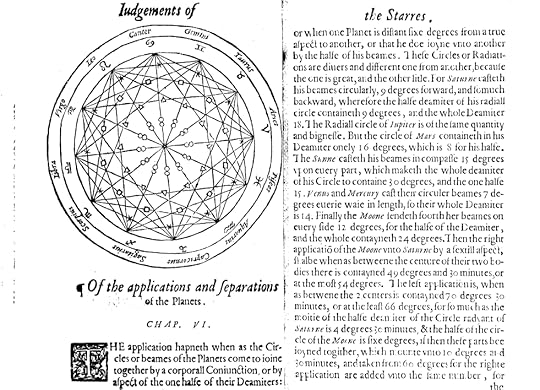Claude Dariot’s System of Moieties
Claude Dariot was a 16th century French astrologer who influenced the way in which aspects were being evaluated, in his 1557 French text L’introduction au jugement des astres (Introduction to the Judgement of the Stars). William Lilly refers to Dariot’s system and the use of “moieties” of the orbs of planets. By “orb” Lilly meant the arc of influence of a planet as measured forward or backward from its zodiacal position (what Dariot refers to as “beams”), in other words, the radius of the planet’s sphere of influence. Lilly’s use of the term “orb” differed from the older usage of the term to refer to the diameter of the sphere of influence of the planet.
Here is a relevant page from Dariot’s text:

Transcribing and modernizing a bit the above text:
Of the applications and separations of the Planets.
Chapter VI
“The application happens when the Circles or beams of the Planets come to join together by a corporal Conjunction, or by aspect of the one half of the Diameters:
or when one Planet is distant six degrees from a true aspect to another, or that he do join unto another by the half of his beams.
These Circles or Radiations are diverse and different one from another, because the one is great and the other, little.
For Saturn casts his beams circularly, 9 degrees forward, and so much backward, wherefore the half-diameter of his radial circle contains 9 degrees, and the whole Diameter 18 degrees.
The radial circle of Jupiter is of the same quantity and bigness.
But the circle of Mars contains in his Diameter only 16 degrees, which is 8 degrees for his half.
The Sun casts his beams in compass 15 degrees upon every part, which makes the whole Diameter of his Circle to contain 30 degrees, and the one half, 15 degrees.
Venus and Mercury cast their circular beams 7 degrees every way in length, so their whole Diameter is 14 degrees.
Finally, the Moon sends forth her beams on every side 12 degrees, for the half of the Diameter, and the whole [Diameter] contains 24 degrees.
Then, the right application of the Moon to unto Saturn by a sextile aspect shall be when as between the center of their two bodies there is contained 49 degrees and 30 minutes, or at most 54 degrees.
The left application, when as between the two centers is contained 70 degrees and 30 minutes, or at the most 66 degrees, for so much as the moitie of the half-Diameter [that is, the moitie (half) of the Radius] of the Circle radiant of Saturn is 4 degrees 30 minutes, and the half of the Circle of the Moon is six degrees, if then these parts be joined together, which amount to 10 degrees 30 minutes [that is, 4d 30m + 6d = 10d 30m] and taken from 60 degrees [sextile] for the right application, or added unto the same number for the left, the application will easily be found.
Likewise must you judge of all other aspects of the Planets.”
END OF QUOTE FROM DARIOT.
———————-
In plain English:
Dariot quotes the traditional literature that each planets has an orb or sphere of influence, which has a particular diameter and radius. The planet radiates beams from its body in all directions, and the influence of these beams extends a distance measured by the radius of the sphere (orb) of influence.
For example, the diameter of the sphere (orb) of influence of Saturn is 18 degrees. The radius of this orb is 9 degrees. and the beams that radiate from Saturn are influential up to 9 degrees in all directions from the body of Saturn.
Dariot then proposes using a system of “moities” (aka, moieties) to measure how far apart planets must be to separate from influencing each other. He apparently felt that the traditional method of using orbs was too generous in determining when planets were continuing to influence each other by aspect, so he decided to break with tradition and try something different.
“Moitie” means the exact half-measure of something, as in taking a length and dividing it precisely by 2.
He proposes, for each planet, finding “the moitie of the half-Diameter of the Circle radiant” of the planet, that is finding HALF [the moitie] of the RADIUS [the half-Diameter] of the Circle of beams that radiate out from the body of the planet. Note that half the radius is a quarter of the diameter of the orb of influence of the planet.
For example, the sphere (orb) of influence of Saturn is 18 degrees. The radius (half-diameter) of this orb is 9 degrees, and the moitie of the half-Diameter (radius) is 4 degrees 30 minutes.
You then add the moitie of Saturn (which is half the Radius or a quarter of the Diameter of the orb of incluence) to the moitie [aka moiety] of any other planet aspecting Saturn to determine the maximum distance between the two planets at which the aspect is still within effect.
 Image from https://theafi.wordpress.com/2002/09/03/classical-origins-of-aspects/
Image from https://theafi.wordpress.com/2002/09/03/classical-origins-of-aspects/ Dictionary Definition of Moitié
L’une des deux parties égales d’un tout:
One of two equal parts of a whole.
Anthony Louis's Blog
- Anthony Louis's profile
- 29 followers



